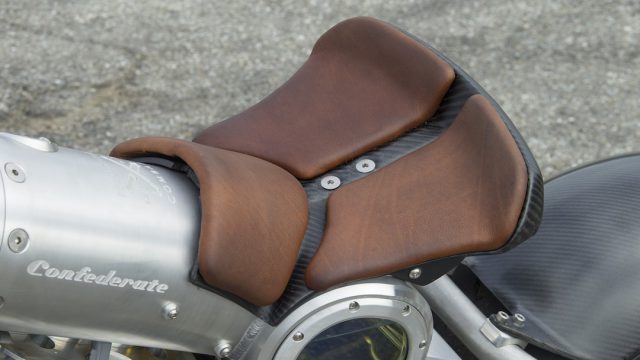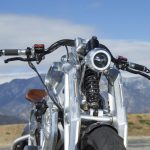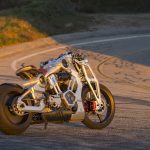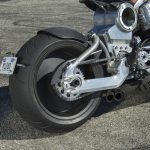World Exclusive Test. An industrial work of art with a purpose – two-wheeled eye candy that functions a whole lot better than you may expect
Confederate has become the boutique bike-building brand of choice for the USA’s rich and famous, with celebrities from Hollywood A-listers Tom Cruise, Brad Pitt and Nicholas Cage, through to rock idol Bruce Springsteen, heading its high-profile roster of owners, often with more than one of these innovatively designed, exquisitely crafted and consequently ultra-costly two-wheeled works of art in their garages.
The Confederate Motor Company has now taken its self-styled Art of Rebellion a stage further with the debut of its visually stunning new P51 Fighter Combat model. Powered by an S&S X-Wedge air/oil-cooled ohv 132ci (2,163cc) 56.25º V-twin motor with two valves per cylinder, this latest example of the functional eye candy which Confederate has displayed a unique talent in developing, is claimed to deliver serious horsepower and immense torque in a fully street-legal package. Its engine architecture has been specifically tailored by the Wisconsin-based engine specialist for the monocoque-framed motorcycle, whose chassis, suspension and engine crankcases have all been carved from solid 6061 aluminium billet.

The new P51 Fighter Combat is offered in two versions. The so-called Blonde bare-metal model comes in at $125,000 plus tax, with the Black Flag variant at $130,000. 31 individually-numbered examples of the former will be manufactured and 30 of the latter, and Confederate’s Sales Manager Paul Adams declares he has deposits for 41 of the total of 61 bikes planned. Hurry, hurry….
By any standards, the Confederate P51 Fighter represents an imaginative step forward in contemporary motorcycle design and manufacture, without in any way courting convention. “We wanted a bike that flicks the finger at the established order – low at the back, high at the front, very narrow, with a straight line expressed from the handlebar to the swingarm pivot, and made very differently, based on an ultra-stiff triangle when viewed from the side,” says Matt Chambers, Confederate CEO & President. “It’s fighting against convention, fighting to make a change – hence the name. It’s for customers who want a kind of f**k you attitude in the design and styling of what they’re riding – and the Fighter gives them that, with the stiffest, lightest chassis capable of housing the greatest amount of torque as a percentage of weight ever achieved in all of motordom."

Matt Chambers, Confederate CEO & President
OK – so how did the G2 Fighter become ring-ready? Both technically and visually a radical update of the G1 version, the motorcycle is dominated by the seven-inch (178mm) diameter aluminium tube comprising its spine frame, two inches (51mm) wider than the G1 version, with the model’s title and emblem carved into the upper face. This fuselage is CNC-machined from solid billets of 6061 aircraft-spec aluminium which are duly bolted together to create a true monocoque chassis holding the S&S X-Wedge motor that’s rigidly mounted as a fully-stressed frame component. Then, just as a conventional Honda or Harley-Davidson’s fuel tank carries the manufacturer’s title on either side, so here the Fighter’s central frame tube is emblazoned with the Confederate name etched into its flanks. That’s because it IS the fuel tank, carrying 4.0 US gallons/16-litres of gas in the lower part of the frame’s spine, extending downwards under the seat – the G1 version’s secondary fuel cell beneath the engine is no more. There’s a total of five sight glasses incorporated in the frame spine, with the upper trio allowing you to peer into the airbox incorporated into its upper section, and the lower pair permitting you to monitor the level in the fuel cell, which starts in the backbone then drops down beneath the seat. Imagine the legendary Isle of Man TT-winning John Player Norton racebike’s aluminium monocoque chassis, but CNC-machined from solid then bolted together, rather than fabricated via a TIG-welder as the Norton was – that’s the P51 Fighter, albeit powered by a very different kind of twin-cylinder engine than the Norton’s relatively puny 75bhp 750cc parallel-twin.

“Back in 1992 when I was working on the original Hellcat, we dreamed of obtaining a V-twin engine with a one-piece forged crankshaft,” says Matt Chambers. “But we’ve had to make do until now with an old-style, bolted-together, five-piece Harley-type crank so that, when you lean into that motor to get the kind of explosive lowdown hit of torque that Confederates are all about, the flexy nature of the crank makes it fall down hard in terms of vibration and robustness. That also meant we couldn’t tie the motor fully into the chassis to create a rigid unitary structure that handled ideally. The S&S X-Wedge powerplant changes all that. It has a forged one-piece crank and big flywheels that allow us to deliver that substantial torque safely and smoothly, and S&S supplies us with a special Confederate version of the motor with a crankcase machined from solid billet, which has dedicated attachment points to specifically suit our frame designs.”
This permits the Fighter’s 132ci./2,163cc air-cooled ‘square’ triple-camshaft 56.25º V-twin pushrod S&S engine measuring 111.76 x 111.76 mm (4.40 x 4.40 in) to be used as a fully-stressed chassis component. In doing so, S&S has incorporated Confederate’s own cassette-style stacked-shaft five-speed gearbox (a format which Confederate was the first to employ two decades ago, two years before Yamaha supposedly invented it on the R1) mounted in a fully-machined transmission housing bolted directly to the back of the S&S motor to create a tight unit construction package. The short 1¾ in/44mm belt primary drive is mounted on the left, matched to a multiplate Bandit dry clutch, and with chain final drive on the right – rather than belt, with the massive amounts of torque and power on tap. How massive is that? Paul Adams explains.
“To customise the Fighter’s S&S motor we went to Jon Kaase www.jonkaaseracingengines.com outside Atlanta, Georgia, who has a well-deserved reputation as an award-winning tuner, especially of Ford drag-racing motors. He’s a cylinder head expert who had never worked on a motorcycle engine before – but he’s created a huge amount more power and torque for us and our customers. Jon basically took the S&S heads, welded in the whole squish area and re-cut it, changed the valve angle, reshaped the combustion chamber, and gas-flowed the head. He raised the compression a bit to 10.3:1 [was 10:1 – AC], and fitted a different piston, with the end result that he got 209 horsepower at the crank from our motor, running with an open exhaust. Jon sends the heads to S&S for them to install on our motors, though we’ve detuned them by adding a silenced exhaust and all the streetlegal niceties, so in production form we have 145 horsepower at 5,200 rpm, and 160 foot-pounds of torque [217Nm], both of them at the rear wheel. But we know from Jon’s work that any customer who wants to tune the motor will get an awful lot of extra performance.” Matt Chambers concurs. “We selected Jon Kaase to work with us because he’s got an awful lot of experience making pushrod motors go fast. We can easily cam the engine for much more power, but for me it’s happiest at 5/10ths or 6/10ths of maximum potential. By the way, the P51 nomenclature relates to the 51mm intake ports he’s installed. The fact that it’s also the designation of the P-51 Mustang fighter aircraft which claimed 4,950 enemy aircraft shot down during World War 2, and was our answer to your Spitfire, is a pure coincidence!” Kaase’s work means that in stock form the new P51 Fighter is the most powerful Confederate model yet to reach the marketplace, so it should go faster than the 176.458 mph that customer James Hoegh managed on a stock X-Wedge powered Hellcat at the Bonneville Salt Flats in 2014, to set a new AMA Land Speed Record for the 3,000cc class.

The chance to check Jon Kaase’s – and Confederate’s – report card came by becoming the first person outside Confederate to ride the new Fighter in the San Gabriel Mountains north of Los Angeles aboard the first bike off the production line. Paul Adams had brought it to California to demonstrate it to movie producers interested in featuring it on-screen, as well as to members of Hollywood’s glitterati who are already Confederate customers. So no pressure, then, in keeping it upright while riding it in anger along the switchback, swoopy Glendora Mountain Road towards the snow-capped two mile-high Mount Baldy….
A radical Alabama take on European-type sport biking
Soon as you straddle the new G2 Fighter you realise what a completely different motorcycle this is from its predecessor. For a start, the über-minimalistic seat on that which seemed practically an afterthought has now been replaced by a well-padded throne that’s improbably comfy – my day in the hotseat left me fresh enough to think this might make a neat alternative sports tourer, if you could find anywhere to stow some luggage! For first, last and always this is a radical Alabama take not on US-style feet-forward cruising but on European-type sportbiking, and that’s thanks not only to the truly impressive, totally addictive legions of torque the engine delivers, but also to something as mundane as the position of the footrests, now mounted slightly rearwards of the seat, and a big contrast with the G1 Fighter’s foot-forward cruiser stance which compromised both cornering – you’d deck your heels once you starting trying even reasonably hard – and comfort. The last new Confederate I rode 15 months ago was the Hellcat Speedster created by Pierre Terblanche during his brief stay at the company, complete with a radically different riding position thanks to footpegs that were 18in/460mm further forward than the previous Hellcat variant’s rearsets straight out of any café racer catalogue. The compromised stance this resulted in made you feel pretty detached from the bike, perched atop it unnaturally with your legs straightened out in front of you, so that it was hard to ride the Speedster in anything approaching anger, as Confederate riders unquestionably relish doing.

With Terblanche departed to Royal Enfield, Matt Chambers has re-asserted control over the design of his company’s products, and the P51 Fighter’s back-to-the-future riding stance is indeed well-nigh ideal. That’s partly due also to its wide new handlebar compared to the G1 Fighter, which is both dropped and pulled back further than before in an Alabama approximation to the Swinging ‘60s one-piece Ace ‘bars so popular back then with the café racing fraternity. Because the whole motorcycle is essentially no wider than the rear tyre, it feels improbably agile – nimble, even, with the reduced gyroscopic effect of the BST carbon front wheel and downsized quartet of Beringer brakes helping speed up the steering, so that you don’t need to give the wide handlebar such a big tug to make it switch direction from side to side. Even without being able to grip the spine frame between your knees, you feel at one with a bike which steers and handles brilliantly – yes, I was surprised, too. I honestly doubt that anything else on two wheels could have got me up the tortuous Glendora Mountain Road any faster than the Fighter, thanks to its thunderous torque and surprisingly agile handling. Surprising, because that’s in spite of the long 1588mm wheelbase and conservative steering geometry, with a 27.5º rake to the machine-hewn girder fork, and 106mm of trail. This delivers super-stable handling downhill into a tight bend, when the girder-type fork design of the type favoured by John Britten, here machined from solid aluminium to hold down the unsprung weight and offering 114mm/4.35in wheel travel, keeps right on working at damping out road rash as you trailbrake into the turn. The RaceTech shocks fitted front and rear have been set up to give optimum damping and excellent ride quality, and I was especially impressed by way the Fighter feels so taut and sporty-handling, as well as confidence inspiring in the way it steers.

Handles better than its predecessor
That’s in spite of the fashion statement of a rear tyre that’s been inflicted on the Fighter by the adoption of a massive 240/45-ZR17 Pirelli Diablo Rosso II. This didn’t heavy up the steering as much as I expected, especially compared to the G1 Fighter or the Speedster, and I surprised myself by using much more of the tyre than I’d ever done before on other bikes fitted with such a wide hoop, with the inevitable chicken strips much narrower than usual. There were two reasons for that, and one is the innate better handling of the G2 Fighter which encourages you to keep up turn speed via a greater angle of lean, with the sound of the pair of exit pipes on each side of the exhaust silencer under the engine scraping on the deck a good early warning system to tell you you’re reaching the limits of the 19-inch front Pirelli Night Dragon. The other is the fact that the fat rear tyre is mounted on a slightly wider-than-usual 8.5-inch BST carbon rim. This spreads the rubber out more, resulting in a flatter profile delivering a more progressive feel – you don’t sense the Fighter falling into the apex of a turn as you reach the shoulder of the tyre once you get to a certain angle, as on other bikes wearing such a wide rear design feature.
Firing up the X-Wedge powerplant used to take a little while on the Speedster and other bikes fitted with it. No more: thumb the starter button and it cranks immediately into life first time, every time. That’s because S&S has fitted it with its Easy Start cams, which reduce cranking compression via an innovative feature. Each of the two exhaust cam lobes are equipped with a spring loaded compression release lobe on the heel of the cam, at the point where the valve would normally be fully closed. This lobe holds the exhaust valve open slightly at cranking speed, which releases some of the compression, making the engine much easier to turn. Once it starts firing, revs increase until at 800rpm the compression release lobe is centrifugally retracted, and the exhaust valve closes fully as part of the normal engine cycle, so that the engine now runs normally, with full compression. Clever!

The new P51 version feels more refined
When that happens, the Fighter’s engine bursts into life with a satisfyingly meaty peal of thunder from the exhaust canister beneath the engine, settling to a 900rpm idle that’s quite devoid of the clackety rattles and shakes of other American air-cooled V-twins, and it’s also relatively quiet in terms of decibels, too. Really, the whole bike exudes quality and represents a decisive step up in terms of togetherness and finish than the previous Fighter – this new P51 version no longer feels like a collection of parts, but a more homogeneous, more refined whole.
In spite of the fact that S&S declines to fit any vibration-sapping counterblancers, and the engine is rigidly mounted in the frame, the X-Wedge motor is improbably smooth by air-cooled American V-twin standards, with zero undue vibration at any revs in spite of being solid-mounted for extra chassis stiffness. Thanks to the more refined response delivered by the Delphi EFI now fitted to replace the G1 Fighter’s carbs, it’ll pull cleanly off idle with acres of grunt and very satisfying acceleration. Just crack the throttle open in almost any gear you care to throw at it, and the Confederate surges forward irresistibly but very controllably – engine mapping is ideal, without so fierce a throttle response that it becomes snatchy, and wheelies aren’t an issue because of the long wheelbase. The impressive acceleration comes thanks to the huge amount of torque on tap at almost any engine speed, which peaks at just 2,000 rpm but holds hard and strong all the way through to the 5,800rpm revlimiter which you have no business ever remotely approaching.

The X-Wedge motor’s happy zone is between 1,500-3,500 rpm, and you’re best shifting up at 4,000 rpm as shown on the bike’s only instrument, a large black-faced Motogadget analogue tacho behind the steering head that’s very café racer, containing a small digital panel showing road speed and the fuel level, with a red ignition light, green N-for-Neutral, and – that’s all. Doing so will let you surf that so-strong torque curve, but you must remember that while 3,000rpm in top/fifth gear is already 100mph/160kmh, it takes you very little time to get there thanks to those substantial reserves of muscle. Though the surprisingly light-action hydraulically operated Bandit clutch (surprising, because of all the torque it has to handle) barely needs to be troubled accelerating out of even the tightest turn from little more than walking pace, you’re best off keeping the revs dialled up above 1,800 rpm to avoid any trace of transmission snatch. But there’s acres of torque from there on up to the 5,200 rpm power peak, where the triple-camshaft 2,136cc motor delivers 145 bhp at the rear wheel, 25bhp more than in the X-Wedge motor’s initial Confederate application in the Speedster – Jon Kaase did his job well, in also delivering 27Nm/20 ft-lb more torque, as well.
The shift action of the five-speed Confederate gearbox is quite positive, swapping ratios smoothly except from second to first, when there’s a clunk each time you go through neutral while shifting down. However, with so much torque on tap, two of those five ratios are completely superfluous – you can start off from rest in third gear without slipping the clutch unduly, and the P51 Combat will go almost anywhere in top gear, with simply magnificent roll-on performance from any revs. This is a great bike for close quarters traffic combat, using the S&S engine’s meaty response to zap past cars or trucks as you carve your way past them in a very Latin fashion. But while you expect all that from such a big-cube motor, the fact that this impressive performance is delivered with such extra refinement and so little vibration, is really noteworthy.

The Fighter’s brakes are equally leading edge and are the same as found in the new Brough Superior SS100, with a quartet of Beringer 230mm aluminum-ceramic composite floating front discs, doubled up in two pairs, gripped by four-piston radial one-piece calipers employing special sintered metal pads to stop a bike weighing 261kg/575lb with oil and 3.75 USgal/4lt of fuel, with a balanced 48/52% weight distribution. They work brilliantly well in stopping the P51 Fighter from the high-speed velocity it’s so fully capable of reaching, and completely resolve the complaints I had about the original G1 Fighter being underbraked, with just a single front disc. However, there’s a caveat: the Beringer package’s initial take-up is so strong that I wouldn’t like to ride this bike on a road surface made slippery by rain or traffic residue. It’s much too fierce even with the Fighter’s substantial weight, and needs attention, probably via a different choice of pads.

No question, Confederate’s new P51 Fighter Combat is the best bike yet built by the Dixie manufacturer. Low, lean and very meaty, it’s engaging to ride while paradoxically more refined in feel and build quality, which is notably higher than on the previous Fighter. It’s expensive and classy, yet muscular and substantial – industrial art with a purpose, but also eye candy that functions a whole lot better than you may expect, especially in terms of handling. Perhaps reflecting Confederate’s growing maturity as a company, the P51 Fighter seems a better rounded, more dynamically refined package than its G1 predecessor, while still delivering a visceral thrill when you ride it hard, as it invites you to do. That’s not to say that Chambers & Co. have sacrificed any of the undoubted thrill you get by twisting the wrist and gassing it wide open as you head for the horizon in fast forward mode – just that the way the Fighter delivers this mega-performance is simply smoother and more refined, less raw-edged than before. As it celebrates its 25th birthday, Confederate has grown up – and that’s reflected in the refined charisma of this very impressive new model.
Photo credit: Kevin Wing






































